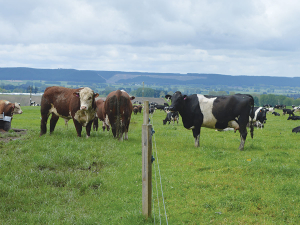Good bull management means running adequate numbers of bulls with the herd, reducing their stress, and handling bulls to minimise the risk of injury to people and animals, says DairyNZ.
Having enough bulls when cows are likely to be on heat is important for good reproductive performance.
The number of bulls needed will depend on how many cows or yearling heifers are likely to come on heat while the bulls are with the group.
DairyNZ recommends farmers run one yearling bull per 20 yearling heifers at all times to cover the poorer performance of yearling bulls. Ensure there are always at least two sexually active bulls running with each mob throughout the mating period.
Bulls are typically run with yearling heifers on an all-in basis. You may want a few extra bulls around in case any need to be replaced. The ratio should be about one bull to 15-20 heifers.
“If you are using heat synchrony, and returns will occur when bulls are running, you need to estimate the minimum number of bulls running with cattle during this period (using one bull per 10 non-pregnant cows).
“Alternatively, resume heat detection and AB for three-four days, starting 19 days after the previously synchronised inseminations.”
To make sure bulls are sexually mature and able to serve, bulls need to be well grown. By the time a bull reaches 14–15 months, it should have achieved 50% of its mature weight. This should increase to 85% by two years of age.
To maintain the health of bulls and all other animals, ensure bulls get the same vaccination as the heifers and cows. Develop a drenching programme with your vet as well.
Select bulls from a bull rearer or leasing service with a reputation for growing and delivering healthy bulls. Ask what disease exposure bulls may have had, such as Thieleria or BVD. Insist on bulls certified free of TB, BVD, IBR and EBL, and blood tested negative for Johne’s disease. If unsure about Johne’s, discuss it with your vet.
Insist on bulls certified fully vaccinated for leptospirosis and BVD. They must have been vaccinated twice initially, four weeks apart and then boosted with a single shot annually for each of these diseases.
Use bulls no older than three years. Older bulls can be temperamental and difficult to manage, and are more likely to have injuries to the penis, back or legs. They increase the risk of injury to the cattle and to the farm workers.
Choose virgin bulls whenever possible as they are less likely to introduce venereal diseases to the herd, but avoid using bulls younger than 15 months old. If using non-virgin bulls, discuss with your vet a test for the venereal diseases Trichomoniasis and Campylobacter.
Use bulls that are likely to minimise the number of calvings requiring assistance, especially with the heifers.
Select bulls ideally from the same mob. This will reduce fighting when they are with the herd. Otherwise the bulls need to arrive earlier to establish their social order well before mating start date.
Exclude fully horned bulls and those with deformed feet.
Select bulls of similar size to the cows or heifers to be mated. If bulls are substantially heavier than the cows or heifers (e.g. >100kg heavier) then injuries to both bulls and cows are more likely.
Watch bulls serving tall cows, to ensure they are able to serve correctly. Also observe larger bulls serving cows. If the cows collapse under the weight, find lighter bulls.
Before bulls arrive
Bulls need to be kept in good body condition, particularly in the three months prior to their mating start date.
Several weeks before the bulls will be used, make any required diet changes to ensure bulls are not too fat or too thin. They should be in body condition score 4.5 to 5.5 prior to mating. Score them well before mating to give you time to make diet changes.
Consider getting your vet to examine the bulls at least one month before the bulls start work. Examinations range from a simple physical exam, to a serving ability test, or a full assessment of semen quality.
When bulls arrive
Good bull management will ensure bulls are well adjusted to their environment before mating and have been through a biosecurity quarantine.
Bulls should be moved to the farm two-three months to ten days before they are required for work.
Split the bulls into teams for rotating (half resting, half working) to reduce fighting.
On arrival:
• check for injuries possible during transport
• quarantine for 10 days and watch for disease or walking defects
• trim hooves if necessary
• walk among them, watching for any bulls that show aggression or ‘stalking’ behaviour, especially Jersey bulls – they may not be suitable to run with the milking herd.


















